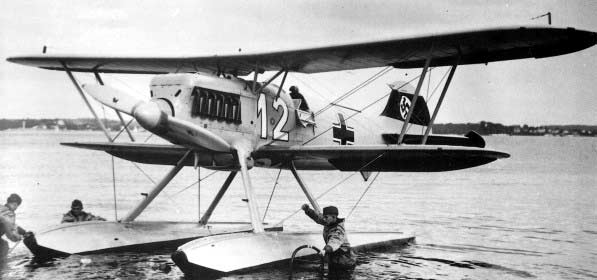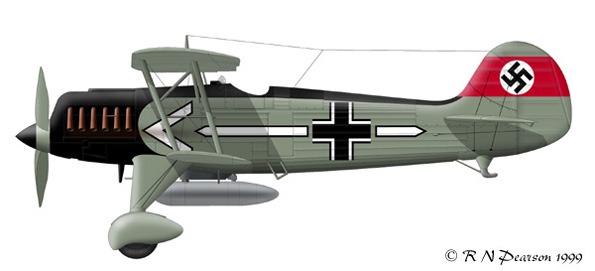
|
 |
Heinkel He 51 |
 |
 |
 |
 |
 |
|---|---|---|---|---|---|---|---|
 |
 |
 |
 |
 |
|||
 |
|||
|
The He 51A-1 equipped with floats, was the forerunner of thirty-eight He 51B-2 floatplane fighters, fitted with twin aluminum floats. It was equipped to be launched on Kriegsmarine cruisers and other large warships. | |||
| While the sleek Heinkel He 51 looked like it had the "Right Stuff," unfortunately this was not the case as the Heinkel He-51 turned out to be a completely orthodox biplane of undistinguished performance. Part of its shortcoming could have been attributed to the failure of the German aircraft industry to develop a suitable high-performance engine, as was happening in Great Britain at Rolls-Royce. It had been hoped that the He-51 would exceed or match opponents such as its contemporary, the Hawker Fury powered by a Kestrel engine, but it was not to be, since it was nowhere near as maneuverable as that famous classic. | |||
| The He 49a, first flown in 1932, was of traditional constructed fabric covered steel-tube fuselage and wood frame wings. It was designed by Walter Gunter and complemented by the mathematic genius of his twin brother Siegfried, which became the prototype, He 51a, registered as D-ILGY. What was important about the He-51 from a design standpoint was its elegance of line, and top speed of almost 199 mph (320 km/h), which was in keeping with its true role as a forerunner of the first fighter to serve with Luftwaffe, upon its official formation in April 1935.1 |
|
The origins of the He 51 can be traced back to a series of streamlined fighters beginning with the He 37 in the 1920s, and continued with the He 38, He 43 and He 49.2 The Technischen Amt of the Luftfahrtkommisariat became interested when it was revealed it had a higher performance than the Arado Ar-65E which was planned as the first fighter equipment of the still-secret Luftwaffe, with the same BMW VI engine, but the He 51 now showed promise as a fighter that would meet international requirements.
The initial preproduction He-51A-0 fighter, first flown in 1933, equipped the Mitteldeutsche Reklamestaffel, (Central Germany Publicity Squadron), which would later become the core of Jagdgeschwader, JG132 "Richtofen," when the Luftwaffe was revealed to the rest of Europe in 1935.3 Early accidents were laid to deficiencies in training rather than anything intrinsic to the design. The He-51B structure was strengthened, including twin-wire bracing of the landing gear, and a provision for a 50-liter drop tank beneath the fuselage was added. As production proliferated in 1936-37, so did the Jagdgeschwader mounted on the elegant-looking fighter, with their colorful unit markings. The beginning of the end for the He-51 came in January 1936. The Luftwaffefuhrungsstab considered that the Arado Ar-68 offered little over the Heinkel in terms of performance and questioned putting it into production. Ernst Udet, Inspector of Fighter and Dive Bomber Pilots, decided to resolve the question. At comparative trials in Brandenburg, mounted in the Ar-68E, with a very experienced pilot in an He-51, Udet out-climbed, out-dove and out-maneuvered the Heinkel fighter with ease.4 Like the He 51, the Ar-68a was also originally equipped with a BMW VI engine, but citing poor performance, the engine was replaced with Junkers Jumo 210, inverted-Vee engine.5

He 51 graphic courtesy of History in Illustration In July of 1936, a major air war began in Spain prompting requests from General Francisco Franco to Hitler, to provide air support to the Nationalists. At the beginning of the war, only thirty-six domestically built Nieuport Ni D.52s were available of which twenty-nine were in possession of Republican forces.6 Six He-51s were sent to Spain with six German pilots to instruct Spanish pilots. Unfortunately, the airplane was a "handful" for the Spanish, who immediately wrote off two of them. The Germans Condor Legion entered combat and met with such success, that it allowed Luftwaffe pilots to gain invaluable air combat experience. It was about this time that Polikarpov I-15s and Polikarpov I-16s, flown by Soviet "volunteers" appeared on the side of the Republicans. When the opponents met, it was no contest as to which was the better: the "Chato" and "Rata" could fly rings around the Heinkel, as well as outgun it, and the He-51s were reduced to targets, unfit to take part in aerial combat. Even Adolph Galland, commander of He 51 squadron 3/J88, a future ace of WWII, had no opportunity to gain victories in Spain.7 By the end of the war, almost two-thirds of He 51s sent to Spain were lost in combat.8 He-51C-1s, fitted with bomb racks to carry up to six 22-lb (10 kg) bombs, continued service as ground attack fighter, a role this version was designed for, remained in service in Spain, while the Luftwaffe's He 51C-2 were replaced as rapidly as possible, after the He 51s poor showing at the comparative trials at Brandenburg.9 In retrospect, the failure of the He-51 when it entered combat was ultimately a good thing for the Luftwaffe, since it forced the service to bring the Messerschmitt Bf-109 into operational use far earlier than would otherwise have been the case, subjecting that great design to the pressure of wartime development from the beginning of its career, and assuring it of the ascendancy it would hold, when war finally broke out in Europe. The introduction of the Bf-109 into combat, enabled pilots of the Luftwaffe to abandon the outdated three-plane fighter Vic formations, and develop the double-pair or Schwarm formations.10 Height was becoming a significant factor used in dive and zoom attacks to catch the fast and modern bombers coming into use at the time, such as the SM.79, Heinkel He III and Dornier Do.17.11 |
| Heinkel He 51B-1 |
Specifications: |
|---|---|
| Dimensions: | |
| Wing span: | 36 ft 1 in (11.00 m) |
| Length: | 27 ft 6-3/4 in (8.40 m) |
| Height: | 10 ft 6 in. (3.20 m) |
| Weights: | |
| Empty: | 3,219 lb. (1,460 kg) |
| Max Gross: | 4,178 lb (1,895 kg) |
| Performance: | |
| Max Speed: | 205 mph (330 km/h) |
| Ceiling: | 25,262 ft. (7,700 m) |
| Normal Range: | 354 miles (570 km) |
| Powerplant: | |
|---|---|
|
BMW VI 7.3Z 750 hp (559 kW) for TO, 12 cyl. inverted vee, liquid cooled engine. |
|
| Armament: | |
| Two upper front fuselage 7.9 mm MG 17, machine-guns. | |
| Endnotes |
|---|
|
1. David Mondey. The Concise Guide to Axis Aircraft of World War II. New York, Smithmark Publishers, 1984. 80. 2. Kenneth Munson. Fighters Between the Wars, 1919-39. New York, The Macmillan Company, 1960. 127. 3. Joachim Dressel and Manfred Griehl. The Luftwaffe Album, Bomber and Fighter Aircraft of the German Air Force 1933-1945. London, Arms and Armour Press, 1994. 7. 4. Ibid. 10. 5. David Mondey. 13. 6. Norman Franks. Aircraft Versus Aircraft, The Illustrated Story of Fighter Pilot Combat from 1914 to the Present Day. London, Grub Street, The Basement, 1998. 66. 7. Ibid, 67. 8. Kenneth Munson. 9. Ibid. 10. Norman Franks. 68. 11. Norman Franks. 67. |
Created February 18, 2007. Updated October 21, 2013.